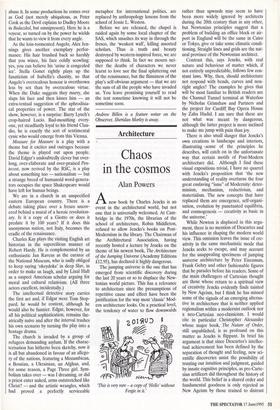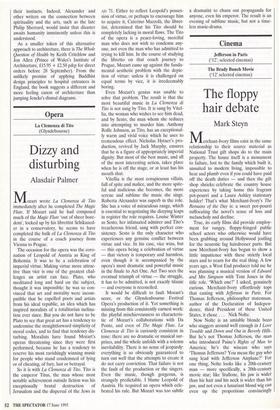Architecture
Chaos in the cosmos
Alan Powers Anew book by Charles Jencks is an event in the architectural world, but not one that is universally welcomed. At Cam- bridge in the 1970s, the librarian of the school of architecture, Robin Middleton, refused to allow Jencks's books on Post- Modernism in the library. The Chairman of the Architectural Association, having recently hosted a lecture by Jencks on the theme of his newest book, The Architecture of the Jumping Universe (Academy Editions £12.95), has declared it highly dangerous.
The jumping universe is the one that has emerged from- scientific discovery during the last 20 years or so to displace the New- tonian world picture. This has a relevance to architecture since the presumptions of repetitive cause and effect have been the justification for the way most 'classic' Mod- ern architecture looks. On a practical level, the tendency of water to flow downwards `This is very rare - a copy of 'Hello' without Fergie in it.' rather than upwards may seem to have been more widely ignored by architects during the 20th century than in any other, but Newtonian principles suggest that a problem of building an office block or air- port in England will be the same in Cairo or Tokyo, give or take some climatic condi- tioning. Straight lines and grids are the nat- ural province of the Newtonian architect.
Contrast this, says Jencks, with real nature and behaviour of matter which, if not entirely unpredictable, follows few con- stant laws. Why, then, should architecture not respond with bends, curves and non- right angles? The examples he gives that will be most familiar to British readers are the Channel Tunnel terminal at Waterloo by Nicholas Grimshaw and Partners and the project for Cardiff Bay Opera House by Zaha Hadid. I am sure that these are not what was meant by dangerous, although the latter project is more inclined to make me jump with pain than joy.
There is also small danger that Jencks's own creations in landscape and interiors, illustrating .,some of the principles he describes, will catch on in the unfortunate way that certain motifs of Post-Modern architecture did. Although I find these visual expositions trivial, I have no quarrel with Jencks's proposition that 'the new understanding of reality overturns the four great enslaving "isms" of Modernity: deter- minism, mechanism, reductivism, and materialism. The new concepts that have replaced them are emergence, self-organi- sation, evolution by punctuated equilibria, and cosmogenesis — creativity as basic in the universe.'
While Newton is displaced in this argu- ment, there is no mention of Descartes and his influence in shaping the modern world view. This omission leaves the issue of cre- ativity in the same mechanistic mode that Jencks seeks to escape, and may account for the unappealing specimens of jumping universe architecture by Peter Eisenman, Frank Gehry and other fashionable figures that he parades before his readers. Some of the main challengers of Cartesian thought are those whose return to a spiritual view of creativity Jencks evidently finds tainted by New Ageism, but I think he has missed some of the signals of an emerging alterna- tive in architecture that is neither applied regionalism within a modernist outlook nor a neo-Cartesian neo-classicism. I would cite in particular Christopher Alexander whose major book, The Nature of Order, still unpublished, is as profound on this matter as Jencks is flippant. In brief his argument is that since Descartes's intellec- tual achievement has been defined by the separation of thought and feeling, new sci- entific discoveries assist the possibility of trusting our intuition and judgment, guided by innate cognitive principles, as pre-Carte- sian artificers did throughout the history of the world. This belief in a shared order and fundamental goodness is only rejected as New Ageism by those trained to distrust their instincts. Indeed, Alexander and other writers on the connection between spirituality and the arts, such as the late Philip Shepard, would insist that disaster awaits humanity imminently unless this is understood.
As a smaller token of this alternative approach to architecture, there is The Whole Question of Health by Keith Critchlow and Jon Allen (Prince of Wales's Institute of Architecture, £15.95 + £2.50 p&p for direct orders before 28 September). From the unlikely premise of applying Buddhist design principles to hospital entrances in England, the book suggests a different and more feeling canon of architecture than jumping Jencks's dismal diagrams.



































































 Previous page
Previous page